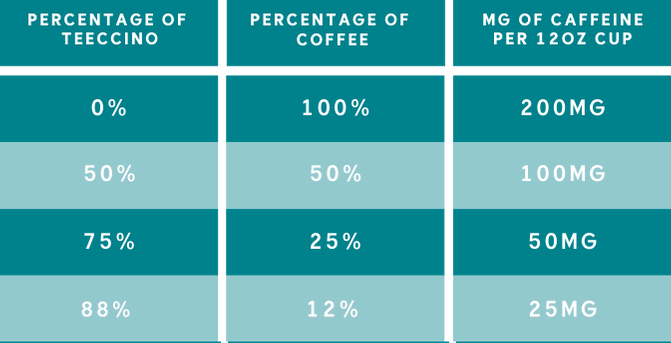Decaf Coffee & Health

Decaf Coffee & Health
More on the effects of caffeine:
Can you trust decaf?
The majority of coffee drinkers who want to cut down on caffeine think, “I’ll just drink some decaf instead.” They may have some qualms about the decaffeination process, so they buy the healthier type of decaffeinated coffee made from water processed or CO2 extracted coffee beans. But let’s stop to think for a moment. Processed? Extracted? What does that do to the beneficial phytochemicals in coffee like antioxidants? What does it do to the flavor? Is decaffeinated coffee healthy to drink?
Decaffeinated coffee still has caffeine
Decaffeinated coffee by law has to have 97% of its caffeine removed. No decaffeination method is able to remove 100% of the caffeine.
A 12 oz cup of decaf contains anywhere from 10-17 mg of caffeine. A 16 oz Starbucks® Grande contains 12-23 mg, and a 20 oz Venti contains upwards of 28 mg! If you order a cup of decaf coffee at a coffee bar or restaurant, independent studies have shown a great variance in the amount of caffeine in the cup, even on the same day and from the very same place. There is no safe and sure way of knowing how much caffeine you may get from a cup of decaf coffee.
“The important point is that decaffeinated is not the same as caffeine-free,” says Roland Griffiths, PhD, professor of behavioral biology and neuroscience at the Johns Hopkins School of Medicine in a news release for a study conducted by the University of Florida on caffeine content in decaf coffee. “People who are trying to eliminate caffeine from their diet should be aware that popular decaffeinated espresso drinks such as lattes (which contain two shots of espresso) can deliver as much caffeine as a can of Coca-Cola — about 31 milligrams.”

Decaffeinated coffee loses antioxidants during extraction
All decaffeinated extraction methods either soak or steam the coffee beans with water in order to extract the caffeine. Soaking the beans is like brewing a very strong, concentrated cup of coffee. Steaming opens up the pores of the beans so that whatever solvent used can enter the beans and remove the caffeine.
Boiling or steaming water changes the coffee bean’s phytochemical structure during decaffeination. This is due to the exposure to extreme heat and the resulting hydrolysis of coffee’s chlorogenic acids that are water soluble antioxidants.
Decaf coffee becomes chemically altered and degraded compared to natural, non-decaffeinated coffee beans. Although both decaf and regular coffee lose antioxidant compounds during the roasting process, decaf coffee has a higher loss of chlorogenic acids after roasting, possibly due to the chemical changes the coffee beans underwent during decaffeination.
Chemical solvents used in decaffeination may be harmful to your health
The most common method of decaffeinating coffee uses chemical solvents, which may leave residues on the beans. Some coffee brands claim to use a “100% natural water process,” but in fact, this coffee may have been soaked in several chemical solvents such as methylene chloride, a base for paint strippers, and ethyl acetate, also known as dry cleaning fluid. First, the beans are steamed for 30 minutes and then soaked for 10 hours in chemical solvents. The beans are then steamed again to remove most of the solvents before they can be called “100% natural water process” decaffeinated coffee. The FDA permits residues of these solvents to remain on the decaf coffee beans after roasting.
Although it is claimed that only trace amounts of solvents remain in decaf coffee beans, studies show that decaf coffee drinkers have a higher incidence of rheumatoid arthritis. One theory is that this could be due to residues of the chemicals used in decaffeination.
Decaffeinated coffee is highly acidic
People typically complain that decaffeinated coffee doesn’t taste nearly as good as regular coffee. Highly acidic coffee beans are used to make decaf in order to have some flavor remaining after the beans have been soaked, steamed, and/or exposed to solvents. Coffee has an acid flavor profile, and thus, decaf coffee needs to have some acid left after the decaffeination process. While Robusta coffee is considered to be inferior to the higher-valued Arabica beans in flavor, its acidity makes it better for decaffeinated coffee.
Coffee drinkers may find that they can drink regular coffee without stomach problems, but not decaf because of the higher acidity. Too much acidity causes health problems that include heartburn, ulcers, inflammatory bowel conditions, osteoporosis, and urinary tract inflammations.
Negative health effects of decaf coffee
Scientific studies show that decaf coffee can have the following effects on your health:
- Both decaf and regular coffee increase the release of gastrin, the hormone that stimulates the release of stomach acid.
- Both decaf and regular coffee increase pressure on the esophageal sphincter, showing that other compounds in coffee besides caffeine are responsible for the acid reflux response after drinking coffee.
- Both decaf and regular coffee cause minerals to be excreted in urine including calcium, magnesium and zinc. Loss of minerals combined with increased acidity can lead to bone loss and osteoporosis.
- The chlorogenic acid in both coffee and decaf impedes the absorption of iron.
- Decaf raises LDL cholesterol, fatty acids and apolipoprotein B, whereas regular coffee seems to not have this effect.
- Decaf coffee, like regular coffee, increases homocysteine, a compound associated with increased risk of heart disease.
- Drinking decaf coffee rather than regular coffee does not lower a person’s risk of heart attack, whereas studies show that drinking green tea does lower the risk of heart attack. Therefore, it seems that compounds in coffee other than caffeine contribute to increased risk of heart attack from coffee drinking.
- Both decaf and regular coffee increase pressure in the eye, which increases the risk of developing glaucoma.

Making your own low acid “decaf” coffee
If you want to drink coffee with lower amounts of both caffeine and acidity, you can make your own “decaf” by combining regular coffee with naturally caffeine-free herbal coffee. The herbs, grains, fruits and nuts used to make herbal coffee are completely caffeine free. They contain water-soluble antioxidants and phytonutrients that are natural and unadulterated because they haven’t had to undergo processing like decaf coffee beans.
Teeccino Herbal Coffee is both naturally caffeine free and non-acidic. Teeccino has an alkalizing effect because it contains bioavailable potassium, the electrolyte mineral that the body uses to correct metabolic acidity. When Teeccino is combined with regular coffee, it reduces the amount of caffeine in a cup and also reduces the acidity.
By combining Teeccino with regular coffee, you can also create a brew with the amount of caffeine you want. Since Teeccino brews just like coffee, you can blend Teeccino’s all-purpose grind with your favorite brand of coffee in your coffee maker or French press.

Here is the approximate amount of caffeinein combinations of coffee and Teeccino:
Brewing instructions:
When brewing Teeccino in a coffee maker, you only need 1 rounded tablespoon of Teeccino for every 2 cups (10 fluid oz) of water. Coffee, however, is typically brewed with 1 tablespoon for each cup (5 fluid oz) of water. People who like lighter coffee will use less coffee. Use the following quantities to guide you in making your own decaf coffee:
In a 12-cup pot of coffee:
| Desired Caffeine Strength | Amount of Regular Coffee | Amount of Teeccino |
|---|---|---|
| 50% | 4-6 Tbsp | 3 Tbsp |
| 25% | 3-4 Tbsp | 4 Tbsp |
| 12% | 1-2 Tsbp | 5 Tbsp |
Featured collection
-
Instant Miraculous Mushrooms® Adapt & Protect Herbal Latte
Regular price $24.99Regular priceUnit price / per$27.49Sale price $24.99Sale -
Herbal Coffee Sampler
Regular price $25.99Regular priceUnit price / per$34.99Sale price $25.99Sale -
Instant Miraculous Mushrooms® Adapt & Protect Herbal Coffee
Regular price $19.99Regular priceUnit price / per$21.99Sale price $19.99Sale -
Instant Miraculous Mushrooms® Cacao +5
Regular price $19.99Regular priceUnit price / per$21.99Sale price $19.99Sale





